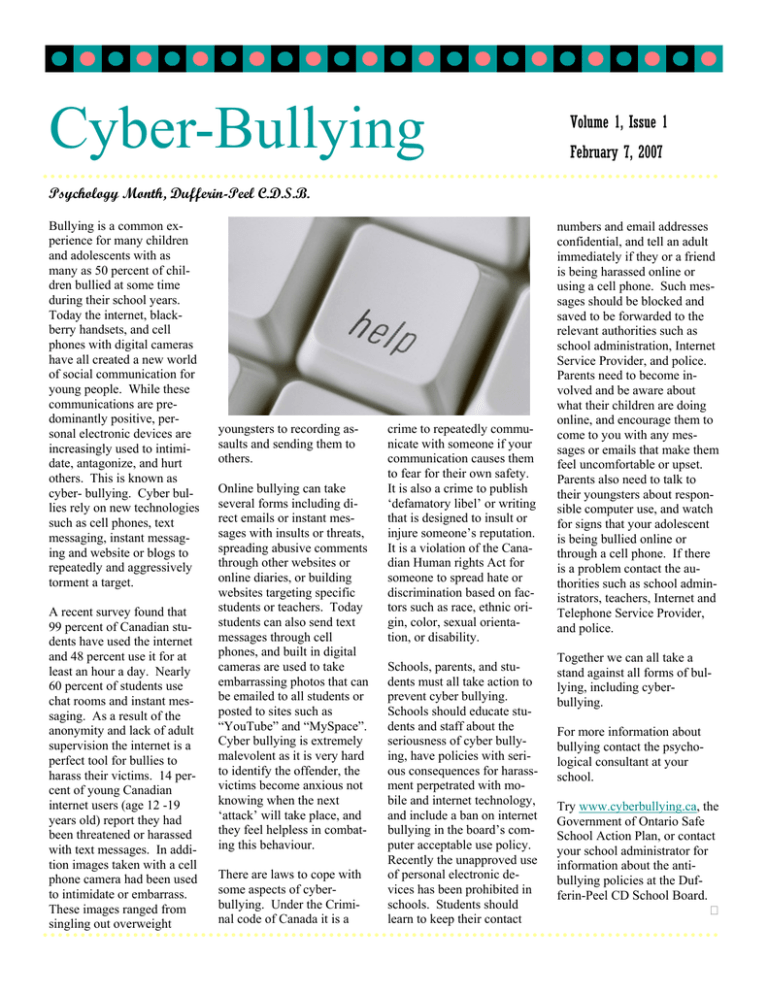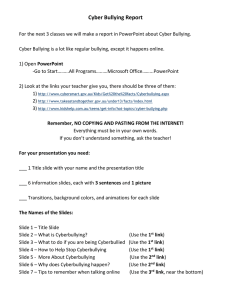Cyber-Bullying
advertisement

Cyber-Bullying Volume 1, Issue 1 February 7, 2007 Psychology Month, Dufferin-Peel C.D.S.B. Bullying is a common experience for many children and adolescents with as many as 50 percent of children bullied at some time during their school years. Today the internet, blackberry handsets, and cell phones with digital cameras have all created a new world of social communication for young people. While these communications are predominantly positive, personal electronic devices are increasingly used to intimidate, antagonize, and hurt others. This is known as cyber- bullying. Cyber bullies rely on new technologies such as cell phones, text messaging, instant messaging and website or blogs to repeatedly and aggressively torment a target. A recent survey found that 99 percent of Canadian students have used the internet and 48 percent use it for at least an hour a day. Nearly 60 percent of students use chat rooms and instant messaging. As a result of the anonymity and lack of adult supervision the internet is a perfect tool for bullies to harass their victims. 14 percent of young Canadian internet users (age 12 -19 years old) report they had been threatened or harassed with text messages. In addition images taken with a cell phone camera had been used to intimidate or embarrass. These images ranged from singling out overweight youngsters to recording assaults and sending them to others. Online bullying can take several forms including direct emails or instant messages with insults or threats, spreading abusive comments through other websites or online diaries, or building websites targeting specific students or teachers. Today students can also send text messages through cell phones, and built in digital cameras are used to take embarrassing photos that can be emailed to all students or posted to sites such as “YouTube” and “MySpace”. Cyber bullying is extremely malevolent as it is very hard to identify the offender, the victims become anxious not knowing when the next ‘attack’ will take place, and they feel helpless in combating this behaviour. There are laws to cope with some aspects of cyberbullying. Under the Criminal code of Canada it is a crime to repeatedly communicate with someone if your communication causes them to fear for their own safety. It is also a crime to publish ‘defamatory libel’ or writing that is designed to insult or injure someone’s reputation. It is a violation of the Canadian Human rights Act for someone to spread hate or discrimination based on factors such as race, ethnic origin, color, sexual orientation, or disability. Schools, parents, and students must all take action to prevent cyber bullying. Schools should educate students and staff about the seriousness of cyber bullying, have policies with serious consequences for harassment perpetrated with mobile and internet technology, and include a ban on internet bullying in the board’s computer acceptable use policy. Recently the unapproved use of personal electronic devices has been prohibited in schools. Students should learn to keep their contact numbers and email addresses confidential, and tell an adult immediately if they or a friend is being harassed online or using a cell phone. Such messages should be blocked and saved to be forwarded to the relevant authorities such as school administration, Internet Service Provider, and police. Parents need to become involved and be aware about what their children are doing online, and encourage them to come to you with any messages or emails that make them feel uncomfortable or upset. Parents also need to talk to their youngsters about responsible computer use, and watch for signs that your adolescent is being bullied online or through a cell phone. If there is a problem contact the authorities such as school administrators, teachers, Internet and Telephone Service Provider, and police. Together we can all take a stand against all forms of bullying, including cyberbullying. For more information about bullying contact the psychological consultant at your school. Try www.cyberbullying.ca, the Government of Ontario Safe School Action Plan, or contact your school administrator for information about the antibullying policies at the Dufferin-Peel CD School Board.


